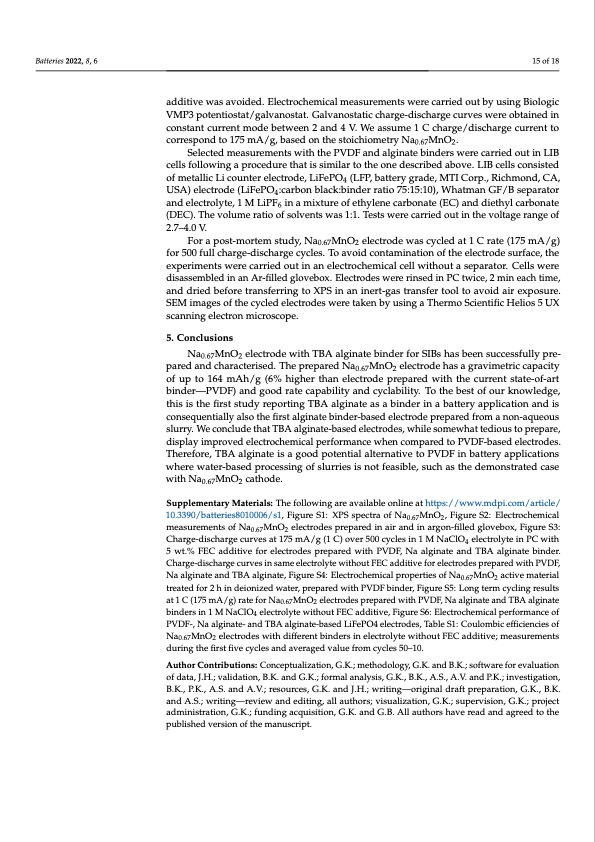
PDF Publication Title:
Text from PDF Page: 015
Batteries 2022, 8, 6 15 of 18 additive was avoided. Electrochemical measurements were carried out by using Biologic VMP3 potentiostat/galvanostat. Galvanostatic charge-discharge curves were obtained in constant current mode between 2 and 4 V. We assume 1 C charge/discharge current to correspond to 175 mA/g, based on the stoichiometry Na0.67MnO2. Selected measurements with the PVDF and alginate binders were carried out in LIB cells following a procedure that is similar to the one described above. LIB cells consisted of metallic Li counter electrode, LiFePO4 (LFP, battery grade, MTI Corp., Richmond, CA, USA) electrode (LiFePO4:carbon black:binder ratio 75:15:10), Whatman GF/B separator and electrolyte, 1 M LiPF6 in a mixture of ethylene carbonate (EC) and diethyl carbonate (DEC). The volume ratio of solvents was 1:1. Tests were carried out in the voltage range of 2.7–4.0 V. For a post-mortem study, Na0.67MnO2 electrode was cycled at 1 C rate (175 mA/g) for 500 full charge-discharge cycles. To avoid contamination of the electrode surface, the experiments were carried out in an electrochemical cell without a separator. Cells were disassembled in an Ar-filled glovebox. Electrodes were rinsed in PC twice, 2 min each time, and dried before transferring to XPS in an inert-gas transfer tool to avoid air exposure. SEM images of the cycled electrodes were taken by using a Thermo Scientific Helios 5 UX scanning electron microscope. 5. Conclusions Na0.67MnO2 electrode with TBA alginate binder for SIBs has been successfully pre- pared and characterised. The prepared Na0.67MnO2 electrode has a gravimetric capacity of up to 164 mAh/g (6% higher than electrode prepared with the current state-of-art binder—PVDF) and good rate capability and cyclability. To the best of our knowledge, this is the first study reporting TBA alginate as a binder in a battery application and is consequentially also the first alginate binder-based electrode prepared from a non-aqueous slurry. We conclude that TBA alginate-based electrodes, while somewhat tedious to prepare, display improved electrochemical performance when compared to PVDF-based electrodes. Therefore, TBA alginate is a good potential alternative to PVDF in battery applications where water-based processing of slurries is not feasible, such as the demonstrated case with Na0.67MnO2 cathode. Supplementary Materials: The following are available online at https://www.mdpi.com/article/ 10.3390/batteries8010006/s1, Figure S1: XPS spectra of Na0.67MnO2, Figure S2: Electrochemical measurements of Na0.67MnO2 electrodes prepared in air and in argon-filled glovebox, Figure S3: Charge-discharge curves at 175 mA/g (1 C) over 500 cycles in 1 M NaClO4 electrolyte in PC with 5 wt.% FEC additive for electrodes prepared with PVDF, Na alginate and TBA alginate binder. Charge-discharge curves in same electrolyte without FEC additive for electrodes prepared with PVDF, Na alginate and TBA alginate, Figure S4: Electrochemical properties of Na0.67MnO2 active material treated for 2 h in deionized water, prepared with PVDF binder, Figure S5: Long term cycling results at 1 C (175 mA/g) rate for Na0.67MnO2 electrodes prepared with PVDF, Na alginate and TBA alginate binders in 1 M NaClO4 electrolyte without FEC additive, Figure S6: Electrochemical performance of PVDF-, Na alginate- and TBA alginate-based LiFePO4 electrodes, Table S1: Coulombic efficiencies of Na0.67MnO2 electrodes with different binders in electrolyte without FEC additive; measurements during the first five cycles and averaged value from cycles 50–10. Author Contributions: Conceptualization, G.K.; methodology, G.K. and B.K.; software for evaluation of data, J.H.; validation, B.K. and G.K.; formal analysis, G.K., B.K., A.S., A.V. and P.K.; investigation, B.K., P.K., A.S. and A.V.; resources, G.K. and J.H.; writing—original draft preparation, G.K., B.K. and A.S.; writing—review and editing, all authors; visualization, G.K.; supervision, G.K.; project administration, G.K.; funding acquisition, G.K. and G.B. All authors have read and agreed to the published version of the manuscript.PDF Image | Na-Ion Batteries Tetrabutylammonium Alginate Binder

PDF Search Title:
Na-Ion Batteries Tetrabutylammonium Alginate BinderOriginal File Name Searched:
batteries-08-00006.pdfDIY PDF Search: Google It | Yahoo | Bing
Salgenx Redox Flow Battery Technology: Salt water flow battery technology with low cost and great energy density that can be used for power storage and thermal storage. Let us de-risk your production using our license. Our aqueous flow battery is less cost than Tesla Megapack and available faster. Redox flow battery. No membrane needed like with Vanadium, or Bromine. Salgenx flow battery
| CONTACT TEL: 608-238-6001 Email: greg@salgenx.com | RSS | AMP |